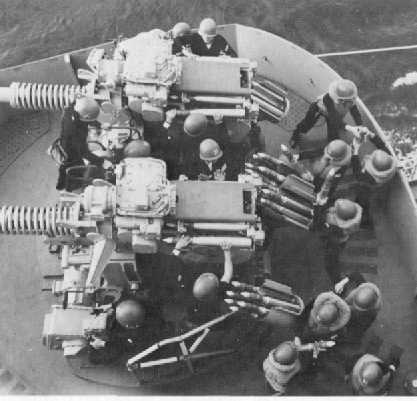
This is an outline of a talk I gave on 7/31 to other Docents (Tour Guides) and Student Interns about the 3" 50 Cal Gun. While the Mark 22 (shown above) was used on most Destroyer Escorts with 3" 50 Cal.; the USS Slater has Mark 26 mounts.
- Basics
- 3" Diameter
- 50 Caliber: Gun Length = Caliber * Diameter (3*50=150")
- Range - 14,600 yards, 29,400 ft Ceiling
- Rate of Fire - 15 rounds per minute
- Dual Purpose - A/A, Surface
- Muzzle Velocity 2,700 fps
- Recoil Length - 11-1/2"
- # used: WWII Start - 690; WWII End - 14,002
- Chrome Plated Barrel, 4,300 rounds
- Main Components
- Barrel - Gun
- Housing - Breech
- Slide - Recoil/Counter Recoil Mechanism
- Mount (vs. Turret), Stand
- Elevation / Train Power Drives
- Sight Setter - Sights
- Fuse Setter
- Ready Service Ammo Boxes
- Salvo Latch, Hand Operating Level
- Operation - Gun Crew
- 11 Man Crew
- Mount Captain
- Pointer
- Trainer
- Sight Setter
- Loader (Plug man)
- Hot Shell Man
- Fuse Setter (2)
- Ammo Passers (2)
- Sight Checker
- Pointer, Trainer, Sight Setter Duties depended on Mount Mark
- Hand Served - Loaded by Hand
- Fired Local or Remote
- Using Trigger (Electric) or Foot Pedal
- Operation - Fire Control - Basics
- Influence of Gravity
- Wind
- Time of Flight, relative to target speed/course
- Temperature
- Range
- Ship Speed and Direction
- Roll
- Rifling
- Vibration (Gun vs. Director Control)
- Parallelex (Deviation from Director)
- Roller Path Distortion
- Ship Distortion - Flex
- Gear Distortion - Play
- AA - Fuse Setting Lag to load
- History - Gun Mount and Fire Control Changes
- Mark 20 - Manual
- Mark 22 - Director Input (not control)
- Mark 26 - Director Control
- Later Changes - Mark 27, Twin 3"-50
- Maintenance
- Routine Maintenance - Grease, Oil, Paint
- Effects of Salt Water (31 vs 33)
- Chamber and Barrel
- After Firing, Cleaning (Soda Ash), Paint Smiley Faces
- Sight Alignment - Bore Gage, Tram, Bore Sight
- Safety
- Hang Fire, Miss Fire
- Cook offs
- Power Drives - Crushing
- Firing Cutouts - Shooting into the ship (none detailed on 3")
- Ouches & Burns
- Ammunition
- Projectile - Approx. 13 lbs
- Fixed ammunition, approx. 7 lbs case (Steel/Brass), 4 lb propellant
- AA - 30 Second Mechanical Time Fuse (Green)
- AA - VT - Variable Time Fuse (Green)
- AP - Armour Piecing (Black)
- HC - High Capacity, Min. Wall Thickness (Green)
- Illumination (Star Shell, Stars and Light Blue)
- Smoke / WP (not available in 3")
- Short Charge
- Overall Effectiveness
- Compared to 5" 38 (55 lbs, 18K yards, enclosed mount)
- USS Reeves - SS Seakay Experience
- AA - Director Control
- VT 3 X effective over MTF AA
- Who Made What
- Naval Gun Factory - Charleston WV
- Naval Gun Factory - Washington DC
- Miehle Printing Press, Blaw-Knox, Baldwin Locomotive
- Arma Corp, Brooklyn NY
- References
- Gun Mount And Turret Catalog, Ordnance Pamphlet 1112, 1945
- 3-INCH MOUNT MARK 20, 21, 22, OP 811, 1943
- U.S. Explosive Ordnance, OP 1664, 1947
- US Navy Administrative History WWII, No. 75, Chapter on 3" Guns
- Navy Weapons, 3"/50 Description
- Fire Control Fundamentals, Navpers 91900, 1953
- USS Slater, 3" Gun
- Naval Ordnance and Gunnery V1, Navpers 10797-A
- Principals of Naval Ordnance and Gunnery, Navpers 10783-B
- DE Docent - 3" 50 Cal Posts

During the training, I was asked about the rate of fire for the 3" twin Mounts (Marks 27-33). It appears that the rate of fire was approximately 50 rounds per minute. As shown in the photo, these guns were loaded from either side, and the loader was synchronized with the cycle of the gun firing. Because the 3" could fire a VT fuse, many of the 40mm mounts were replaced with this type of gun during the post-war era.



